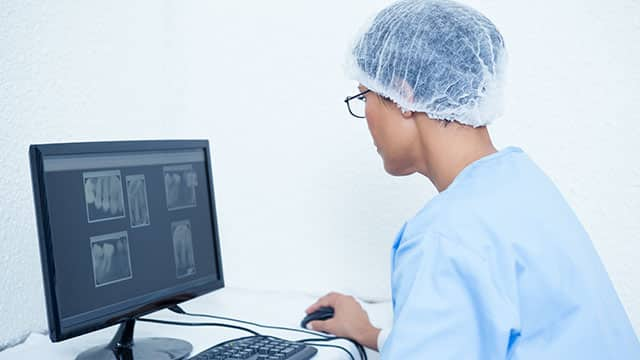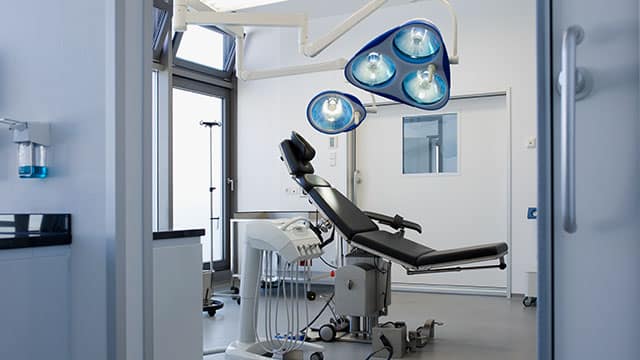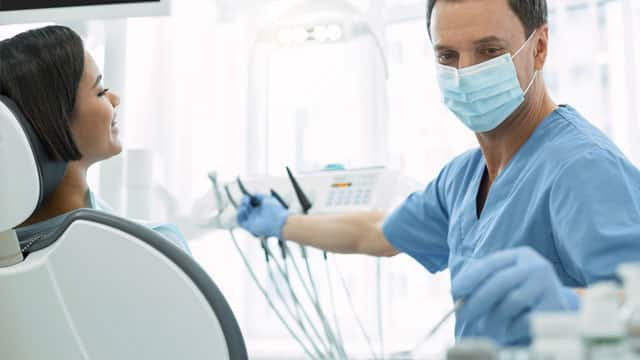What Is Digital Dentistry?
Digital dentistry encompasses any digital or computer-based technology that your dental professional may use to examine, diagnose, and treat the health of your mouth.
Types of Digital Dentistry Used Today
Digital dentistry is transforming just about every aspect of professional oral care from the moment you check in to your appointment to when your dental professionals assess your oral health, to the diagnosis and treatment of any conditions or diseases you may have, to how your dental professional follows-up and interacts with you between appointments. Some digital dentistry tools that you may come across in your appointments include:
Intraoral cameras
Small cameras are fast-replacing the tiny round mirrors dental professionals have historically used to examine the inside of your mouth. One of the biggest benefits of these cameras is magnification. When they can make your tooth about your head's size on a flat screen, they can better identify any potential issues with your oral health that need to be addressed. Another benefit is that they can share what they see with you, allowing you to better understand and improve your oral hygiene. Images can also be shared with lab technicians to match crowns and bridges to the shade of your actual teeth.
Digital radiography
X-rays have been used in dental offices for a very long time, but the traditional x-ray process required film processing, which took time, was expensive, and the prints needed to be filed away in cabinets and physically delivered to other offices and specialists if necessary. Digital radiography is faster. The images are immediately available to see on a computer screen. The files are stored on a server or in the cloud, and the images can be shared easily with specialists if necessary, with an internet connection. Also, according to a summary of X-Rays and Radiographs published by the American Dental Association, there's less exposure to radiation with digital radiology than with the use of x-ray film.
Intraoral scanning and CAD (Computer-aided design)/CAM (Computer-aided manufacturing) technology
There was a time not so long ago when dental professionals would put a gooey substance (impression material) in a mouthguard and place it in your mouth in the right position and have you bite down until it hardened. They'd use that form to make a mold and send it off to a lab where a dental technician creates whatever device you need to repair, replace, or better align your teeth. But the days of impression material in your mouth are no longer necessary because of intraoral scanning and CAD/CAM technology. The scanners make a 3D digital image of your mouth that dental technicians can use to design a prosthesis (crowns, veneers, onlays, inlays, bridges, implant-supported restorations, or dentures), and the prosthesis is then either milled out of a solid block of material or 3D printed.
Learn more about the use of CAD/CAM in dentistry.
Cancer screening tools
Fluorescence imaging can help dental professionals see abnormalities and signs of cancer that may not be visible to the naked eye. When diseases are diagnosed early with these tools, they can be treated at an earlier stage, giving the patient an improved prognosis and a shorter recovery time. A review published in the journal Oral Diseases confirms that this new tool can detect lesions and other potentially malignant disorders.
Digitally guided implant surgery
This relatively new innovation isn't widely used yet. Still, it helps dental professionals identify the most precise and effective way to place an implant in your specific jawbone structure using an intraoral scan. The American Academy of Implant Dentistry says that 3 million Americans have dental implants. That number is growing by 500,000 every year, so this innovation could ensure many people receive the best dental implant possible.
Learn more about dental implants and tooth bridges.
Information management
Not too long ago, dental records were all physical copies stored away in filing cabinets. A mix of technological innovation and federal regulation has motivated dental offices around the country to update their systems. This has improved scheduling, made it easier for your dental professional to access records right when they need them, improved workflows, and simplified patient information sharing between offices when necessary.
Digital technology in dentistry is accelerating rapidly, and dental health professionals who harness scientifically tested and proven advances in their field may be able to offer the best care. Digital dentistry is constantly providing dental professionals with ways in which they can help you in faster, safer, more comfortable, and more reliable ways than they ever have before. That's something you can smile about (IRL or digitally 😃).
Oral Care Center articles are reviewed by an oral health medical professional. This information is for educational purposes only. This content is not intended to be a substitute for professional medical advice, diagnosis or treatment. Always seek the advice of your dentist, physician or other qualified healthcare provider.
ORAL HEALTH QUIZ
What's behind your smile?
Take our Oral Health assessment to get the most from your oral care routine
ORAL HEALTH QUIZ
What's behind your smile?
Take our Oral Health assessment to get the most from your oral care routine















